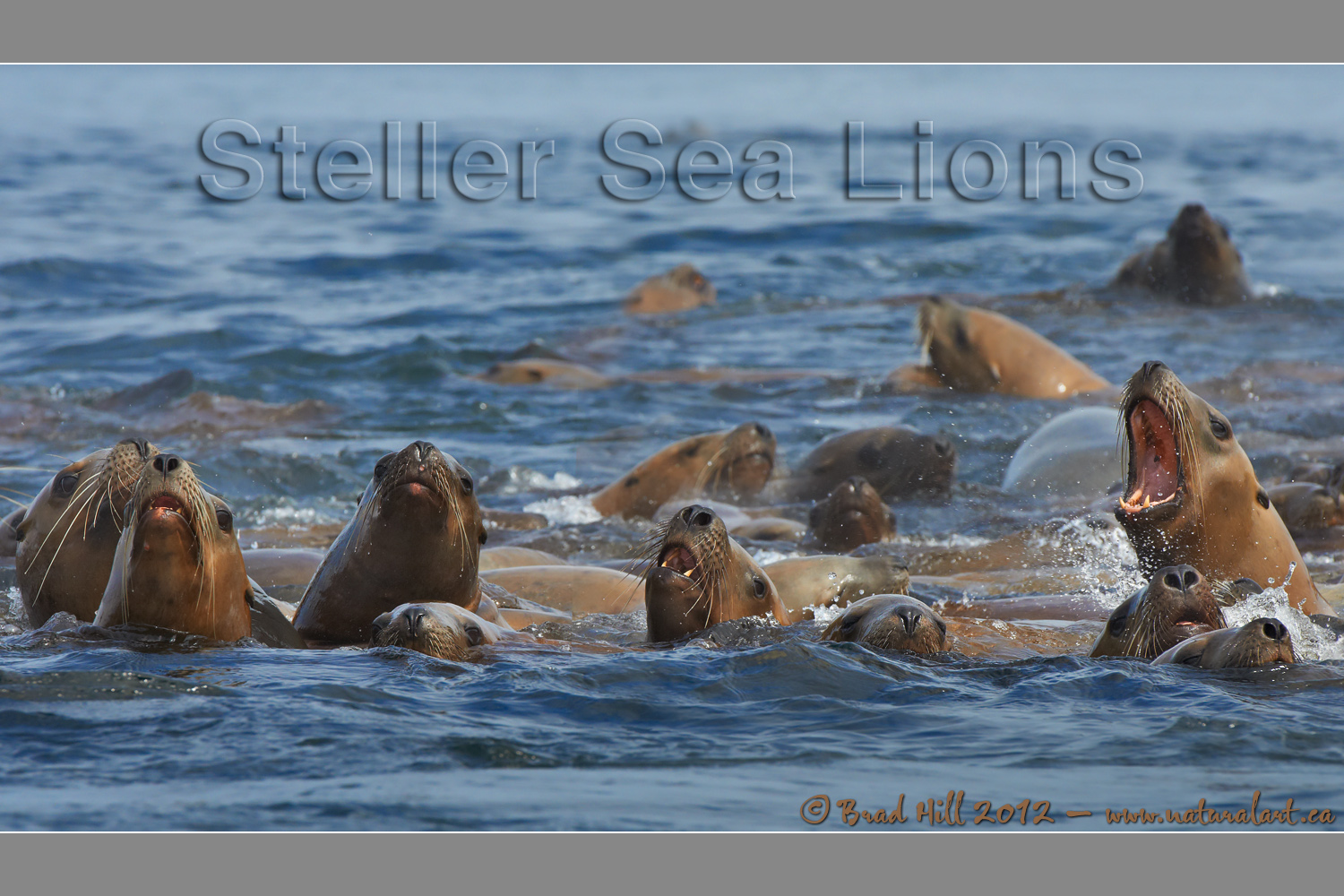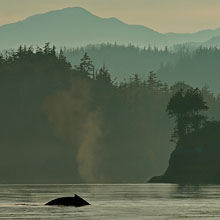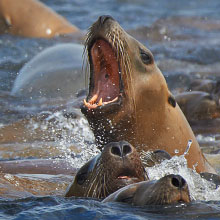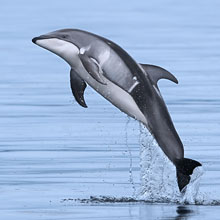Availability: Undetermined - Enquiries?
In the Field
The Welcoming Committee. Northern Vancouver Island, BC, Canada. August 20, 2012.
View additional Steller Sea Lion images beginning here: Steller Sea Lions
To human observers there is probably nothing that appears more chaotic than a large colony of Steller Sea Lions. Whether in the water or up on haul-out rocks, the sea lions are continually barking/braying at one another or, worse yet, showing their teeth and even biting one another. Once in a blue moon the sea lions settle down - but only until one of them moves a muscle and then all heck breaks loose again! While there is obviously SOME organization to these social groupings (it's no coincidence that the largest males sit atop the haul-out rocks), most of the time these colonies seem to be in a stress-filled state of pandemonium!
We approached this colony of sea lions in a small, inflatable boat. When we were still hundreds of meters away from the haul-out rocks the lions were on 40 or of them dove into the ocean. They weren't fleeing - in a matter of seconds they descended upon us and gave us a not-so-royal welcome, swimming all around our boat and barking, braying, and showing their teeth in a pretty threatening fashion. Interestingly, almost all the members of the "welcoming committee" seemed to be sub-adults - there were no massive bulls in this group, nor were there any of the smaller pups. Between the sight, sound, and smell (these guys have an AWFUL odour!) it was a pretty amazing experience!
One of the toughest things in wildlife photography is working with multiple subjects. Getting a great shot of even a single animal is tough, but with each additional subject the number of challenges go up almost geometrically. How can you ensure all the key subjects are in focus? What arrangement of your subjects is visually interesting? How on earth can you get them to arrange themselves in that fashion? How can you ensure that all the key subjects are doing pretty much the same thing (or at least not looking directly away from you?)? While there are a few general rules that can help - things like choosing a slightly shorter focal length lens and stopping down your aperture to maximize your depth of field - it's hard to find too many generalities that can apply to all situations.
I shot this image with a fairly short telephoto lens (70-200mm zoom @ 200mm). Very conveniently, the front row of sea lions "lined up" almost equidistantly from our Zodiac - likely because while each sea lion was curious about us they were also wary, and each of them was reluctant to stray any closer to us than their buddies did. This behaviour pretty much guaranteed that I could keep all the key subjects in focus. Nonetheless, I stopped my aperture down more than I normally do when shooting wildlife (in this case down to f8) to increase my depth of field (to further ensure all the key subjects were in reasonably sharp focus). And, last but not least, the fact that this whole group of sea lions was extremely curious about us and focused on our boat helped keep their actions and behaviour patterns somewhat "cohesive" and at least "pointed" in the same direction! I'd have to check my files, but I think this is the first time I've managed to capture 9 subjects in focus and with none acting in a way that distracts from the others or from what the image is about!
For those wanting to see more detail, here's a 2400 pixel version of this shot:
• The Welcoming Committee: Download 2400 pixel image (JPEG: 1.4 MB)
ADDITIONAL NOTES:
NOTE 1: This image - in all resolutions - is protected by copyright. I'm fine with personal uses of it (including use as desktop backgrounds or screensavers on your own computer), but unauthorized commercial use of the image is prohibited by law. Thanks in advance for respecting my copyright!
NOTE 2: This image was captured during my "Humpbacks, Orcas, Sea Lions & More!" photo tour in the summer of 2012. Each year I offer trips into two different parts of the Great Bear Rainforest as well as one to photograph aquatic mammals and oceanscapes near the northern tip of Vancouver Island. And, in selected years, I also offer photo tours to locations to capture other highly sought-after subjects, such as various owl species of the boreal forest and wildlife of Canada's Arctic. Details about these trips can be found on the Photo Tours page of this website.
NOTE 3: Like all wildlife photographs on this website, this image was captured following the strict ethical guidelines described in The Wildlife FIRST! Principles of Photographer Conduct. I encourage all wildlife photographers to always put the welfare of their subjects above the value of their photographs.
Behind the Camera
The Welcoming Committee. Northern Vancouver Island, BC, Canada. August 20, 2012.
Digital Capture; RAW 14-bit format; ISO 400.
Nikon D800 paired with Nikkor 70-200mm f2.8 VRII lens. Hand-held from Zodiac inflatable boat. VR on and set to "Active" mode.
1/1000s @ f8; -0.33 stop compensation from matrix-metered exposure setting.
At the Computer
The Welcoming Committee. Northern Vancouver Island, BC, Canada. August 20, 2012.
RAW Conversion to 16-bit TIFF, including first-pass/capture sharpening using Capture One Pro. Three raw variants (processed from raw) differing by a total of 1.2 stops in exposure - from -0.5 stops from original exposure to +0.7 stops from original exposure.
Further digital corrections on resulting 16-bit TIFF files using Adobe's Photoshop CS6 and Light Craft's Lightzone. Photoshop adjustments including compositing the raw conversion variants (layering and masking), selective colour saturation and desaturation, and selective sharpening for web output. Final tone tweaking performed using tonemapper/re-light tool in Lightzone.
Conservation
The Welcoming Committee. Northern Vancouver Island, BC, Canada. August 20, 2012.
Species Status in Canada*: Special Concern (November 2003) - protected in Canada since 1970.
The Steller Sea Lion (Eumetopias jubatus) is the largest of the sea-lions, and males can weigh up to a ton (females are considerably smaller and rarely weigh over 600 lb). Males compete among themselves for females, and successful males end up breeding with several females within their harem.
From the early 1900's through to the 1970's huge numbers of Steller's Sea-Lions were culled for their fur and to remove a competitor (for humans) for salmon. During that time approximately 55,000 sea lions were killed and the breeding population of BC was lowered to about 4,000 animals. Since the Steller Sea Lion first received protection in 1970 the population in the coastal waters of BC has grown to between 18,000 to 19,700 animals (7,600 or so of these are of breeding age).
*as determined by COSEWIC: The Committee on the Status of Endangered Wildlife in Canada
























